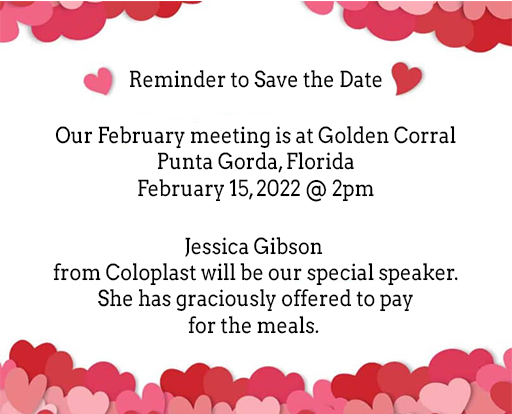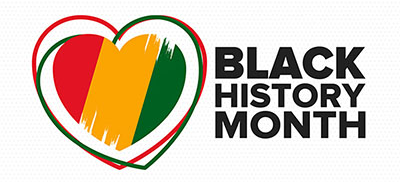
Charlotte County Ostomy Support Group
A 501 (C) (3) nonprofit organization, (tax-deductible donations) Website www.ccosg.org
Officers:
President: Jerry Downs 941-629-7568 fldowns@embarqmail.com
Vice President: Ken Aukett 609-315-8115
Secretary: Lovelle Meester 612-240-2175
Treasurer: Lorelie Godbout 603-474-9063
Directors: Janice Creutzmann 910-382-2509
David Sandora 941-828-1076
Committees:
Newsletter: Lorelie Godbout
Programs & Education: Jerry Downs,
Gloria Patmore, RNET (retired) 941-627-3077
Nancy Frank, RN, BSN, CWOCN 941-629-5118
Marie Michel, RN, CWCA, CHRN, OMS 941-626-2607
Visitation: Nancy Frank, RN, BSN, CWOCN
Library: Lorelie Godbout, RN (retired)
Professional Advisors:
John P. Rioux, MD, F.A.C.S.
Nancy Frank, RN, BSN, CWOCN
Marie Michel, RN, CWCA, CHRN, OM
Newsletter for February 15, 2022

Valentine Luncheon changed from February 8th to Tuesday, February 15th
February is known as Black History Month. It is to focus and celebrate all the accomplishments of Black people and to teach about the history of Blacks

February is also a month to remember President George Washington’s and President Abraham Lincoln’s birthday. The third Monday of February is observed as a legal holiday in most states in honor of the birthdays of George Washington and Abraham Lincoln, known as Presidents Day.

February 14 is Valentine’s Day. It has become a significant cultural, religious, and commercial celebration of romance and love in many regions of the world.
The following article is from the UOAA newsletter.
Herrett Family Story
Caregivers, Ostomy News, Patient Stories, Personal
By Megan Herrett
Adequately summarizing what our family has gone through over the past almost ten years requires going back to the very beginning. Our daughter, Maggie was three months old when we realized that she looked a little jaundiced. Our pediatrician agreed and ran what would be the first of hundreds of tests to determine what was wrong with our baby and why her liver function tests were so elevated. After being seen by multiple specialists here in Boise for a few months, we were referred to a doctor at Primary Children’s Medical Center in Salt Lake City in November of 2008.
Photo by: Natalie Koziuk Photography
When Maggie was about six or seven months old, we noticed that she was starting to scratch quite a bit. Her arms, feet, and ears were covered in scabs and scratch marks. This itching was a side-effect of her liver not processing bile correctly – when not processed by the liver, the bile backs up into the bloodstream and circulates back through the body, resulting in an increased number of bile salts in the body. It is these bile salts in the bloodstream that make an individual with a liver disease very itchy.
At first, we were able to control her itching through several medications but by the time she was 12 months old, her itching had become unbearable. At that time, her liver was deteriorating quickly and she was exhibiting some developmental delays as a result of the incessant itching. In a matter of weeks, she had pulled out all of her hair and she was maxed out on her medication dosages.
We were presented with the option of an ostomy-placing surgery when Maggie was just over one year old as an alternative to a liver transplant. The purpose of her ostomy would be to (1) drain bile from her body to combat the itching, and (2) slow the progression of her disease by giving her liver a much-needed reprieve.
To be honest, I was devastated when I first heard the words, “ostomy bag.” I imagined a life where Maggie would never wear a bikini or be a cheerleader or be captain of her swim team – all very big concepts when you are talking about a one-year-old child. I imagined her being bullied because she was different. But, we needed a solution…and we needed to act quickly.
Maggie underwent ostomy surgery on October 30, 2009, and we haven’t looked back. She is now eight years old and is thriving health-wise as well as academically. Additionally, she is also excelling on a competitive gymnastics team. And although Maggie absolutely beams on the outside, she struggles with confidence because of her ostomy pouch. She is fiercely private and does not want any of her peers to know. My husband and I have worked tirelessly to emphasize to her that her pouch is nothing to be ashamed of – after all, it saved her life and she would not be the person she is today without it.
In 2010, we were blessed by the birth of our son, Winston. We soon discovered that he was plagued with the same disease and would then undergo the same surgery when he was just over one year old. Although this news was devastating at the time, we have come to realize that it was a blessing in disguise. Both of them have the same liver disease and both wear ostomy pouches – commonalities that they can rely on when the going gets tough.
I can still recall my “aha moment” though – that moment when I realized that we would not be a family that sat idly by and let her pouch be a source of shame or embarrassment for her. Maggie was probably two years old at the time and we were in the throes of potty-training, where our previous line of attack of onesies and bib overalls to prevent her from yanking her pouch off were no longer an option. She was finally in a shirt and a pair of pants…and her ostomy bag was peeking out from the hemline of her shirt as we left a restaurant. A man entering the restaurant noticed her ostomy pouch and said, “Ewwwww! What IS that?” Although my initial reaction was one of anger and dismay, it was then that I realized that working with her would be only one piece of the puzzle – we also needed to work with the community to help educate, support, and raise awareness for those like Maggie so that the shame, fear, and embarrassment would fade away to empowerment and pride.
It was this “aha moment” that led me to contact the United Ostomy Associations of America in January of 2016 about bringing their Run for Resilience Ostomy 5k to Boise. My inquiry was met with a resounding “YES!” We held our inaugural race on Saturday, October 8th, and had over 160 people registered for the 5K and Kids’ Mile events. We even had participants, including ostomates and ostomy nurses, drive in for the race from Spokane, Washington, and Lewiston! And Hollister even donated ostomy pouches to include in our race registration bags. If nothing else, I am hopeful that this year we laid the foundation for many successful years to come and got some ostomy-related dialogue started. Instead of “Ewww,” maybe people will say, “Oh, I know what that is and that saved their life!”
How to care for your ostomy
Cleaning, showering and taking care of your ostomy in the best possible way.
Your ostomy is a new part of your body. It may take a while to get used to having a stoma. The swelling should already be subsiding, but it could still be a little swollen.
A little blood is not unusual
The ostomy tissue is very similar to the inside of your mouth – however, the stoma has no nerve endings, and the red color is normal and does not typically indicate pain or inflammation.
It could bleed a little because blood vessels are very close to the surface, but that’s normal – just like the tissue inside your mouth bleeds easily.
Refrain from using soap when cleaning
You should obviously handle your ostomy with care, but there is no need to be afraid of touching it. To clean it, simply use warm tap water and a soft cloth or paper towel.
The ostomy tissue and the skin around it doesn’t need soap for cleansing, and in fact, soap could irritate it and interfere with the adhesion of your barrier.
Bathing with an ostomy
Showering and bathing will not harm your ostomy or your pouching system, so you can shower with or without your pouch as you wish – as long as you remember to keep moisturizing soaps, oils, or creams, etc. away from the stoma.
Let the surrounding skin dry completely before you apply a new barrier – and that’s actually all you need to do.
Information from Coloplast Care is for educational purposes only. It is not intended to substitute for professional medical advice and should not be interpreted to contain treatment recommendations.
You should rely on the healthcare professional who knows your individual history for personal medical advice and diagnosis.




